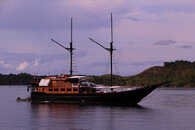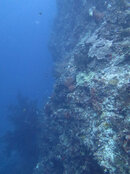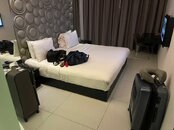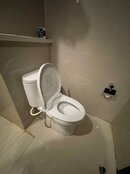VIII.) How Difficult Was The Diving?
The Messenger:
Photo by my room mate Glenn.
Photo of Guests & Crew by our Cruise Director Alexa.
This is relative and I don’t set the bar high as a diver. I’m early 53, 6’1”, around 265-lbs, obese, fairly sedentary (I don’t get winded walking across a room and can walk a mile at a decent clip, but I can’t run it, and I’m not recognized at the gym). I don’t multi-task well and am not great with situational awareness. I think I maintain decent horizontal trim when conditions are good. Most of my diving has been in Bonaire, with a mix of Florida and other Caribbean destinations (28 dives in Cozumel, so I’ve dealt with current/drift diving) and 19 dives in the Galapagos (so I’ve dealt with pangas before). My dive count is over 500. In Cozumel I had trouble drifting faster than the guides. I vary but am not reliably ‘good’ at extended stationary hovering to look at and snap shoot small creatures, especially if I have to drop down a few feet to where the guide is to do it. I am sadly prone to occasionally hit things with a fin when struggling with this juggling act, a deficit I’m ashamed of and keep working to improve. In other words, I dive okay, not great, but task loading is a strain. I have no professional or technical dive training.

Every octopus I saw by day was in a hole, shown me by guides.
At night we saw little ones. I don't think I saw any blue-ringed octopi, though.
“
A man’s got to know his limitations,” – Inspector ‘Dirty’ Harry Callahan,
Magnum Force.
My air consumption rate is fair; 0.60 - 0.65 cf/minute isn’t uncommon in easy diving (my gas consumption rate in cubic feet/minute per my Cobalt 2 for dives 16 – 25 was 0.67, 0.60, 0.60, 0.64, 0.53, 0.64, 0.60, 0.64, 0.67 and 0.78 – the last is the one I called due to fighting current). I rented one of their 13-liter 100-cf tanks (rated fill pressure 3,300 PSI), and still tended to run low on air first. Per my Oceanic VT3 computer, starting gas pressures varied from 2,912 to 3,292 PSI, tending to cluster around 3,000 or a bit more. A typical dive time for me might run around 50 minutes, give or take; I ascended with an SMB and did my safety stop and got on the dinghy; other divers stayed down considerably longer. Aside from the 24 minute dive I called early, my dive times ranged from 41:30 to 66:30 (minutes:seconds).
Disclaimer: from what we were told, staff aim for 60 minute dive times and if not under pressure to keep a schedule are open to longer times if the divers’ air is sufficient. Most people got substantially longer dive times than I did.
We saw plenty of mantis shrimp.
Despite trying multiple masks I’ve resigned myself that leakage (mainly under my nose and cheek ‘laugh lines’ is a thing with me. I’m told Vaseline is petroleum-based so don’t use that, silicone grease was suggested but nowhere near viscous enough, and I’m afraid peanut butter might make fish go at my face. I have to clear my mask often.
My eyes are weird. I’m a bit far sighted in my left eye, quite near-sighted in my right eye (which has a hypoplastic optic nerve and a small cataract; imagine scrawling a spider web pattern with Chapstick on your right glasses lens and trying to read through it), and I can’t make out the tinier macro subjects well. I use an old Canon G16 in a Fantasea housing for snapshots; usually my only custom setting besides underwater scene mode is switching between flash-off and force-flash. On this trip I eventually broke down and started switching in and out of the macro setting, so setting up for a shot, I’d fiddle with the camera settings while trying to get to the guide, hover, clear my mask (while he thinks he’s pointing out where the creature is to me), then get 2 or 3 shots, hope I’m lucky and try to back out and move on.
Crocodile fish.
I dive a BP/W system with an attached Dive Rite thigh pocket; it’s more hassle to get into and out of, but aids horizontal trim (plus it’s paid for and mine). It lacks pockets other than the Dive Rite (where I pack an SMB, because no matter how I rolled it up in the past, it often spewed out the side and trailed by dive’s end). I had not dealt with reef hooks before. My last 2 dives staff let me use an AquaLung BCD so my BP/W rig could dry more; it was okay, horizontal trim a bit harder to maintain and at the surface I was vertical and held high, the bottom of my chin at the surface. I’ve got a size 15 foot and dive 2-XL Deep 6 Eddy fins, mainly with a flutter kick.
Plenty of scorpion fish.
Including this leaf scorpion fish Glenn showed me.
In a group finning into moderate current, you may see leaner and/or fitter people moving forward at a decent clip, while I fin pretty vigorously to hold position or advance slowly. Struggling with current can get me breathing faster, going through my gas faster, exasperated and when I try to control my breathing rate at risk for a CO2 headache. I called one dive nearly 20-minutes in when we were fighting current, I wondered when (and if) we’d get past it, looked up and saw the guide and other divers congregating
in the current to photograph some macro subject, and that flipped my ‘forget this’ button; I waited till the guide looked at me, signaled my intent to ascend, he came over, and I went on up with his okay (note: the Cruise Director later told me we would’ve eventually reached a turn and began a drift dive). That was 1 dive out of 31. I later overheard a guide in a different group working with the French divers who complemented them on their strong kicking ability such that she could go into current.
Disclaimer: I didn’t see up-currents, down-currents, really fast currents or ‘sweep you rapidly away at the surface’ currents. Current strength wasn’t anything that’d impress a mainstream Cozumel diver. The issue was the need to fin against it at times, rather than drift with it continuously. Current direction changes, so planning has to take in site topography, desired places to reach and what the current is doing when the guide sticks his head in the water. We weren’t fighting substantial current most of the time.
Note: If you are fit with good cardio., strong legs and kicking/finning ability and/or your cross-sectional area to push through the water is smaller than mine, you may find Raja Ampat diving not nearly so ‘challenging.’ Current is not constant, sometimes it’s very mild and we did some drift diving. It’s not all difficult, but at times it is.
Tunicates were all over the place on some dives.
In summary, diving in Raja Ampat (my trip) could be easy to moderately challenging on occasion for some, on up to intermittently a strain and sometimes frustratingly difficult for others. My dive game wasn’t quite at the Raja Ampat level, but I had a good time and an enriching trip with a good margin of safety.
Disclaimer: You can’t please all of the people all of the time. Guides try to mitigate current issues, but there’s only so much they can do. Entering current offers advantages for people who can handle it. My aborted dive was near the full moon, which tends to worsen currents. Raja Ampat offers an impressive number and diversity of macro. subjects, guides are needed to find some of those, and many guests much value those observation and photo opportunities (you should see the photos my roommate Glenn was getting with his Olympus TG6 in microscope mode with an external (video?) light!








